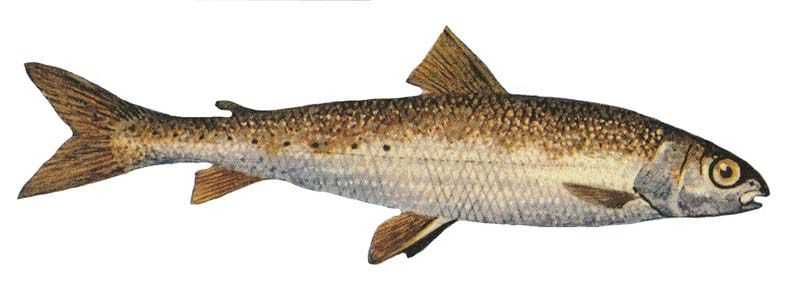Round Whitefish

Species Details
Prosopium Cylindraceum
Salmonidae
Salmoniformes
Lakes, Rivers
2 - 18 lbs.
8" - 22"
Round Whitefish (Prosopium cylindraceum) Fish Description
The Round Whitefish (Prosopium cylindraceum) may not be as popular as any other gamefish out there but they are still sometimes targeted by some anglers for their meat, which is said to be quite tasty. This freshwater fish is a bottom-feeder that mainly eats tiny crustaceans, snails, insect larvae, as well as fish eggs found at the bottom of lakes and rivers.
The fish is named as such because of its roundish midsection and its mostly white-silvery coloration. It has a long and cylindrical body that’s tinged with a light olive-brown on top and the aforementioned mostly silvery-white sides and an even whiter belly. The scales are rather large for their diminutive size and there are also rows of slightly noticeable dark spots that run across the full length of its body. All its fins are orange, amber, to gold in color. It may look a bit like a Cisco or Lake Whitefish but you can tell them apart with the Round Whitefish’s more prominent adipose fin, smaller mouth, and snout, which is slightly pointed downward.
The Round Whitefish spawns in late fall when the water turns a bit colder. Females would lay their eggs over gravel shoals of lakes or at river mouths. Eggs would hatch in about four and a half months and the young would reach maturity in about three to four years or when they reach about twelve inches in length. Their lifespan tends to be around eleven to thirteen years.
Interesting Facts About the Round Whitefish
- The Round Whitefish can grow as much as twenty-two inches long.
- The biggest one ever caught measures nineteen inches long.
- They are quite rarely seen and have been caught just several times.
- They are often hard to catch because of their small mouths and tendency for isolation.
- They are often targeted by anglers for the challenge of catching this rare fish.
- They tend to stay deep in the water, often on rocky lakes and river beds.
- They tend to live solitary lives, congregating only during spawning seasons.
- Aside from humans, Smallmouth Bass and Yellow Perch are known to be their predators.
- They mainly feed on planktons, small crustaceans, insect larvae, and eggs of other fish species.
- Their populations have considerably declined over the past decades due to pollution and the introduction of invasive predatory fish species in their natural habitats.
Size and Swimming Speed
Some Round Whitefish may reach up to twenty-two inches in length but it’s quite rare. Their average sizes tend to be just around eight to twelve inches. Their average speed is not documented but they’ve been observed swimming sluggishly most of the time, with some bursts of speed on short distances when spooked.
Habitat and Distribution
Round Whitefish are mostly found throughout the lakes, rivers, streams, and tributaries in the north-eastern and north-western parts of the country, particularly within the states of Alaska, Maine, New Hampshire, and New York. It is said that they are most abundant in Lake Superior, Lake Michigan-Huron, and Lake Ontario.
They also prefer large-sized lakes and rivers, typically in deep and cold water habitats. You will also find them swimming lake and river beds, just over cobble and gravel substrate in shallow parts of the bodies of water they reside.
Fishing Tips
The best time to fish for a Round Whitefish is during April and May and again in October and November as this is the time when they venture in the shallowest parts of the water. The best baits to use usually are small snails and clams. You will also need to use a light rod and reel, equipped with a tiny hook as these fish have really small mouths.







